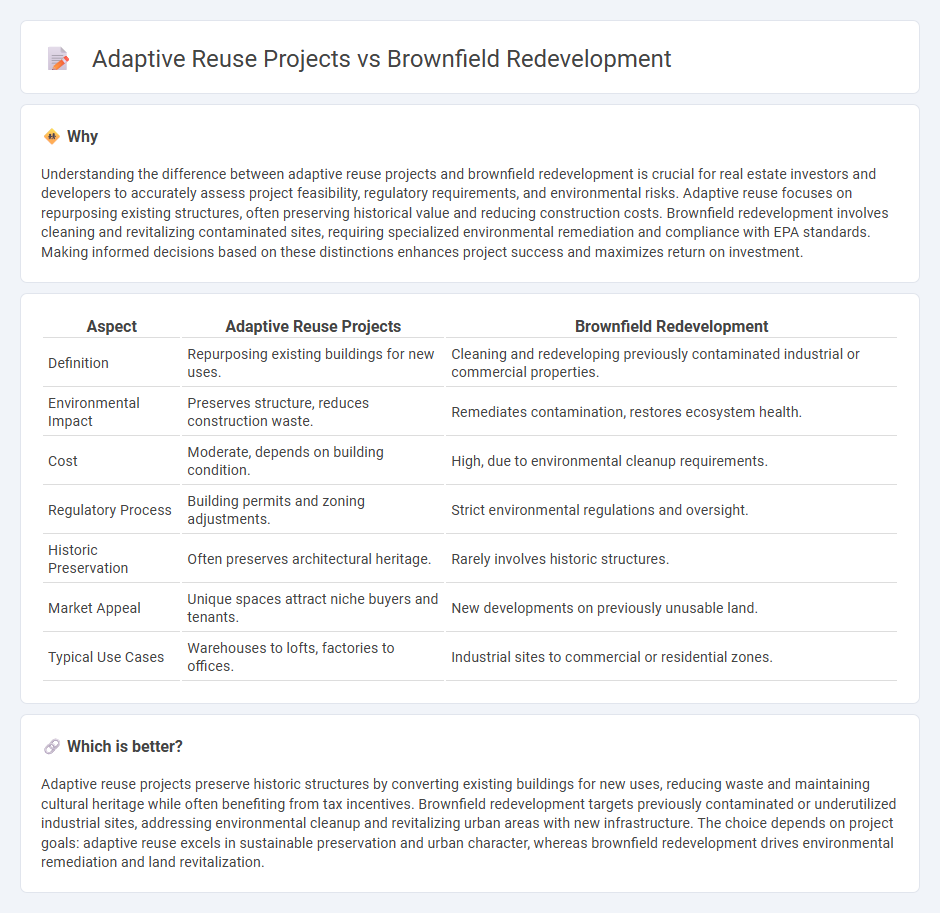
Adaptive reuse projects transform existing buildings into new functional spaces, preserving architectural heritage while reducing construction waste. Brownfield redevelopment focuses on cleaning and repurposing contaminated land, revitalizing underutilized sites in urban areas. Explore how these sustainable real estate strategies reshape communities and drive economic growth.
Why it is important
Understanding the difference between adaptive reuse projects and brownfield redevelopment is crucial for real estate investors and developers to accurately assess project feasibility, regulatory requirements, and environmental risks. Adaptive reuse focuses on repurposing existing structures, often preserving historical value and reducing construction costs. Brownfield redevelopment involves cleaning and revitalizing contaminated sites, requiring specialized environmental remediation and compliance with EPA standards. Making informed decisions based on these distinctions enhances project success and maximizes return on investment.
Comparison Table
| Aspect | Adaptive Reuse Projects | Brownfield Redevelopment |
|---|---|---|
| Definition | Repurposing existing buildings for new uses. | Cleaning and redeveloping previously contaminated industrial or commercial properties. |
| Environmental Impact | Preserves structure, reduces construction waste. | Remediates contamination, restores ecosystem health. |
| Cost | Moderate, depends on building condition. | High, due to environmental cleanup requirements. |
| Regulatory Process | Building permits and zoning adjustments. | Strict environmental regulations and oversight. |
| Historic Preservation | Often preserves architectural heritage. | Rarely involves historic structures. |
| Market Appeal | Unique spaces attract niche buyers and tenants. | New developments on previously unusable land. |
| Typical Use Cases | Warehouses to lofts, factories to offices. | Industrial sites to commercial or residential zones. |
Which is better?
Adaptive reuse projects preserve historic structures by converting existing buildings for new uses, reducing waste and maintaining cultural heritage while often benefiting from tax incentives. Brownfield redevelopment targets previously contaminated or underutilized industrial sites, addressing environmental cleanup and revitalizing urban areas with new infrastructure. The choice depends on project goals: adaptive reuse excels in sustainable preservation and urban character, whereas brownfield redevelopment drives environmental remediation and land revitalization.
Connection
Adaptive reuse projects transform existing buildings or sites, often including Brownfield properties with environmental contamination, into functional real estate assets. Brownfield redevelopment involves the remediation and repurposing of these contaminated lands, making them suitable for adaptive reuse initiatives. This connection promotes sustainable urban development by revitalizing underutilized areas while minimizing environmental impact.
Key Terms
Environmental Remediation
Environmental remediation plays a crucial role in both brownfield redevelopment and adaptive reuse projects by addressing soil contamination, groundwater pollutants, and hazardous materials to restore site safety and meet regulatory standards. Brownfield redevelopment often involves more extensive cleanup due to former industrial use, while adaptive reuse typically requires targeted remediation to support safe building occupancy and operations. Explore in-depth strategies and case studies to understand how environmental remediation shapes sustainable development outcomes.
Historical Preservation
Brownfield redevelopment transforms contaminated or underutilized industrial sites into functional spaces, often requiring extensive environmental remediation to preserve historical elements while meeting modern safety standards. Adaptive reuse repurposes existing structures, maintaining architectural heritage and historical integrity by integrating new uses without significant demolition. Explore the benefits and challenges of both approaches in preserving historical landmarks effectively.
Zoning Regulations
Brownfield redevelopment projects often face stringent zoning regulations that require thorough environmental assessments and compliance with cleanup standards to ensure safe land use. Adaptive reuse projects must navigate zoning codes that determine permissible building functions, historic preservation restrictions, and potential variances for structural modifications. Explore detailed zoning requirements and regulatory strategies to optimize outcomes in both project types.
Source and External Links
Anatomy of Brownfields Redevelopment - Cleaning up and redeveloping a brownfield property enables infill development, increases the tax base, spurs job creation, and incorporates sustainable design and construction techniques.
What is Brownfield Redevelopment? A Guide for Developers - Brownfield redevelopment transforms abandoned, underutilized, or contaminated sites into productive spaces, promoting job creation, local economic growth, urban renewal, and sustainable community benefits.
Brownfields Redevelopment - The Office of Brownfield Remediation and Development provides financial and technical assistance to return contaminated, abandoned, or underutilized sites across Connecticut to productive reuse for mixed-use, residential, commercial, industrial, retail, and open space purposes.
 dowidth.com
dowidth.com